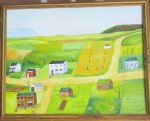Of the thousands of towns in the United States with a population under 2000, Bonneauville is one. Hints of the unincorporated ville can be found as far back as 1789. Bonneauville (Bunichtown etc., see Cat. No, 2999-01a) was but a settlement of a hundred people or so at that time. And that includes farm land populace that bordered the town in every direction.
This Nancy Woodrow folk art painting is a whimsical and warm spirited attempt to show Bonneauville in an earlier, simpler time. The overall view is from the village square facing northward. Bisecting the view horizontally is Hanover Street (Route 116, the Hanover Road.) Upper right going approximately north is Pine Street (The Bonox Road). The street at bottom left heading south (towards the bottom of the picture) is Maple Street. For one block it represents the conjoined routes from Hunterstown to Littlestown (and on to Baltimore), and the road from New Oxford to Two Taverns. These were the town’s first two roads.
The white house at the upper left represents a still standing two-story white clapboard family home. Next to it is a small red building with a "Ditzler" sign. the structure would have been a block or so west of the white home and would have had a pottery kiln. Owner David Ditzler and famed potter Anthony Baecher formerly of Bavaria, once worked there. Third from the right is a white clapboard structure built by Bonneauville's most successful ever entrepreneurs, the brothers Golden. The first floor of the building was used as a general store and the second floor was used as a cigar manufactory. To the right is an apple orchard. In actuality the orchard was located on the opposite (Hanover side) of the road. The stone house on the right of Bonox would been on the left of Bonox. The land there was deeded about 1749. The brown sandstone and log house was the first house of what would become Bonneauville.
Chicken Run was a small stream (not shown) that ran in front of the aforementioned buildings. Now running through a culvert, the open stream crossed Hanover Street just West of the Goldens place. Judging from the lay of the land there. muddy spring road conditions would have caused the merging of the previously mentioned through roads.
The bottom left log structure is one of the earliest buildings of the town. Still standing albeit clad in plastic siding, it was a log hotel that catered to travelers who passed through Bonneauville and were in need of food, rest, and care for their horses. On the corner of Maple and Hanover streets stood Vandykes Blacksmith Shop and Livery. It and the Hotel next door were the nucleus around which Bonneauville, just like many a Pennsylvania town, was formed. A blacksmith's shop livery and hotel were soon followed by homes for proprietors and their families. Supplies were needed on a regular basis. A handsome brick store was built just back from the village green. The open space is still referred to by elderly as "The Square". The general store would eventually become the second location for Bonneauville's post office.
At lower right is a small log structure with a baseball diamond at the rear. This was the first of several schools that would be built is and around the town, The name was Squire Brinkerhoff’s Log School. A remanent of its foundation appears to still exist within the foundation of a larger home now standing at the same location.
In the background of the town are the sweet fields of a spring season. Still further back to the north is a whimsically placed mountainous gap. It strongly resembles Blue Mountain Gap on the Susquehanna River near Harrisburg, PA.
Artist; Nancy Woodrow
Medium; oil on board.
Size: 16" x 20".
Date; March 15, 2022.
"Nancy Woodrow has been creating naive, primitive oil paintings for several decades. Early on, she was inspired by the folky style of Grandma Moses, The professional name of Anna Mary Robertson...an American icon.
Woodrow likes to tell a story of country life in her art, a life she sometimes wishes she had grown up in. It is easy for her to get caught up in a painting that she can imagine herself living in. Old farm houses, barns, ponds cows, cats, sheep, gardens, quilts, anything to do with country life, arranged in varying and sundry order, rare the essence of her paintings.
Woodrow prefers to paint on … sanded board because she can achieve finer details on the smoother surface. ...She paints each work individually, one at a time, and sells only originals.
Woodrow lives in York County, PA"
Source: https://www.ealonline.com/directory/artist.php?id=1600&date=2020
